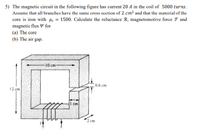
Introductory Circuit Analysis (13th Edition)
13th Edition
ISBN: 9780133923605
Author: Robert L. Boylestad
Publisher: PEARSON
expand_more
expand_more
format_list_bulleted
Concept explainers
Question

Transcribed Image Text:5) The magnetic circuit in the following figure has current 20 A in the coil of 5000 turns.
Assume that all branches have the same cross section of 2 cm² and that the material of the
core is iron with µ, = 1500. Calculate the reluctance R, magnetomotive force F and
magnetic flux Y for
(a) The core
(b) The air gap.
%3D
10 cm-
0.6 cm
12 cm
cm
2 cm
Expert Solution
This question has been solved!
Explore an expertly crafted, step-by-step solution for a thorough understanding of key concepts.
This is a popular solution
Trending nowThis is a popular solution!
Step by stepSolved in 2 steps

Knowledge Booster
Learn more about
Need a deep-dive on the concept behind this application? Look no further. Learn more about this topic, electrical-engineering and related others by exploring similar questions and additional content below.Similar questions
- 2. A C-core with a gap of 0.0001m has a coil number of 100 and a current of 10mA. First find the reluctance of the core given that the Iron core has a negligible reluctance and only the air reluctance contributes to the majority of reluctance. The core has a cross sectional area of 2cm². Next find the flux flowing thru the C-core.arrow_forwardIn the figure is shown a current of 50 A in a wire 120 cm long and at an angle of 45° to a magnetic field of flux density 6.0 x 10 -4 Wb/m2. What are the magnitude and direction of the force on this wire?arrow_forwardThe flux in a magnetic circuit is analogous to . . in electric circuit .......... resistance current emf electric fieldarrow_forward
- 2. AC-core with a gap of 0.0001m has a coil number of 100 and a current of 10mA. First find the Reluctance of the core given that the Iron core has a negligible reluctance and only the air reluctance contributes to the majority of reluctance. The core has a cross sectional area of 2cm^2. Next find the flux flowing thru the C-core.arrow_forwardQ1. Figure 1 shows the magnetic circuit with cross section area of core, 1000 mm2 and current source, 10 mA. By assuming the absolute permeability of core is 2.513x103 H/m, analyze the circuit and determine the following parameters: a. Draw the equivalent Ampere Circuital Law model b. Total reluctance of magnetic circuit c. Magnetic flux at centre and both sided d. Magnetic flux density at centre and air gaps e. Magnetic flux strength at centre and air gaps f. Briefly explain, effect to the magnetic circuit if the length of air gaps keep decreasing and increasing. at 7 cm 30 cm 30 cm 7 cm 7 cm 30 cm 1 cm 400 turns 1 cm 7 cm Figure 1 B-H CURVE BIT) 16 Sheet steel Cast steel 14 12 1.0 08 Cast iron 0.6 04 0.2 H(AUm) 500 1000 1500 2000 2500 3000 3500 4000 4500 5000arrow_forwardSolve all parts.arrow_forward
- The length of a magnetic circuit in a moving iron instrument is 300mm. The coil around the soft-iron core has 360 turns and takes a current of 1.75 A. The core is square in section with sides of 20 mm. Takethe relative permeability of soft iron as 1100. Determine the flux densityarrow_forwardGood and organised Ans result up votearrow_forwardExplain why do we need a B-H curve when we solve a parallel magnetic circuit in which one of the fluxes is give?arrow_forward
- I need the answer as soon as possiblearrow_forward(b) A ferromagnetic is shown in figure Q3(b). Find the value of the current that will produce a flux of 0.005wb. With this current, what is the flux density at the top of the core? What is the flux density at the right side of the core? Assume that the relative permeability of the core is 1000. The depth of the core is 5cm. The other dimensions of the core are as shown in the figure. 15 cm 500 turns 15 cm 45 cm 5 сm 15 cm 10 cm 35 cm Figure Q3(b)arrow_forwardA magnetic circuit constructed of sheet steel has an average length of 1.5 m and cross sectional area of 0.025 m². A 50 turns coil wound on the ring has a resistance of 0.8 N and draws 4 A from A DC supply. The relative permeability is 5000. Determine a) The flux density. b) Voltage applied. c) If the material is replaced with another material with a relative permeability of 3000 and keeping the other parameters as it is then calculate the new flux and explain what happened. 1.arrow_forward
arrow_back_ios
arrow_forward_ios
Recommended textbooks for you
 Introductory Circuit Analysis (13th Edition)Electrical EngineeringISBN:9780133923605Author:Robert L. BoylestadPublisher:PEARSON
Introductory Circuit Analysis (13th Edition)Electrical EngineeringISBN:9780133923605Author:Robert L. BoylestadPublisher:PEARSON Delmar's Standard Textbook Of ElectricityElectrical EngineeringISBN:9781337900348Author:Stephen L. HermanPublisher:Cengage Learning
Delmar's Standard Textbook Of ElectricityElectrical EngineeringISBN:9781337900348Author:Stephen L. HermanPublisher:Cengage Learning Programmable Logic ControllersElectrical EngineeringISBN:9780073373843Author:Frank D. PetruzellaPublisher:McGraw-Hill Education
Programmable Logic ControllersElectrical EngineeringISBN:9780073373843Author:Frank D. PetruzellaPublisher:McGraw-Hill Education Fundamentals of Electric CircuitsElectrical EngineeringISBN:9780078028229Author:Charles K Alexander, Matthew SadikuPublisher:McGraw-Hill Education
Fundamentals of Electric CircuitsElectrical EngineeringISBN:9780078028229Author:Charles K Alexander, Matthew SadikuPublisher:McGraw-Hill Education Electric Circuits. (11th Edition)Electrical EngineeringISBN:9780134746968Author:James W. Nilsson, Susan RiedelPublisher:PEARSON
Electric Circuits. (11th Edition)Electrical EngineeringISBN:9780134746968Author:James W. Nilsson, Susan RiedelPublisher:PEARSON Engineering ElectromagneticsElectrical EngineeringISBN:9780078028151Author:Hayt, William H. (william Hart), Jr, BUCK, John A.Publisher:Mcgraw-hill Education,
Engineering ElectromagneticsElectrical EngineeringISBN:9780078028151Author:Hayt, William H. (william Hart), Jr, BUCK, John A.Publisher:Mcgraw-hill Education,

Introductory Circuit Analysis (13th Edition)
Electrical Engineering
ISBN:9780133923605
Author:Robert L. Boylestad
Publisher:PEARSON

Delmar's Standard Textbook Of Electricity
Electrical Engineering
ISBN:9781337900348
Author:Stephen L. Herman
Publisher:Cengage Learning

Programmable Logic Controllers
Electrical Engineering
ISBN:9780073373843
Author:Frank D. Petruzella
Publisher:McGraw-Hill Education

Fundamentals of Electric Circuits
Electrical Engineering
ISBN:9780078028229
Author:Charles K Alexander, Matthew Sadiku
Publisher:McGraw-Hill Education

Electric Circuits. (11th Edition)
Electrical Engineering
ISBN:9780134746968
Author:James W. Nilsson, Susan Riedel
Publisher:PEARSON

Engineering Electromagnetics
Electrical Engineering
ISBN:9780078028151
Author:Hayt, William H. (william Hart), Jr, BUCK, John A.
Publisher:Mcgraw-hill Education,